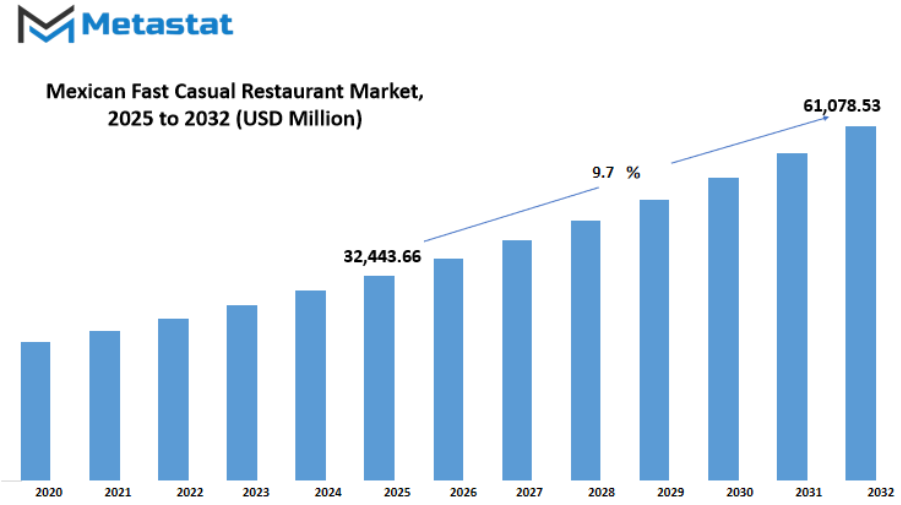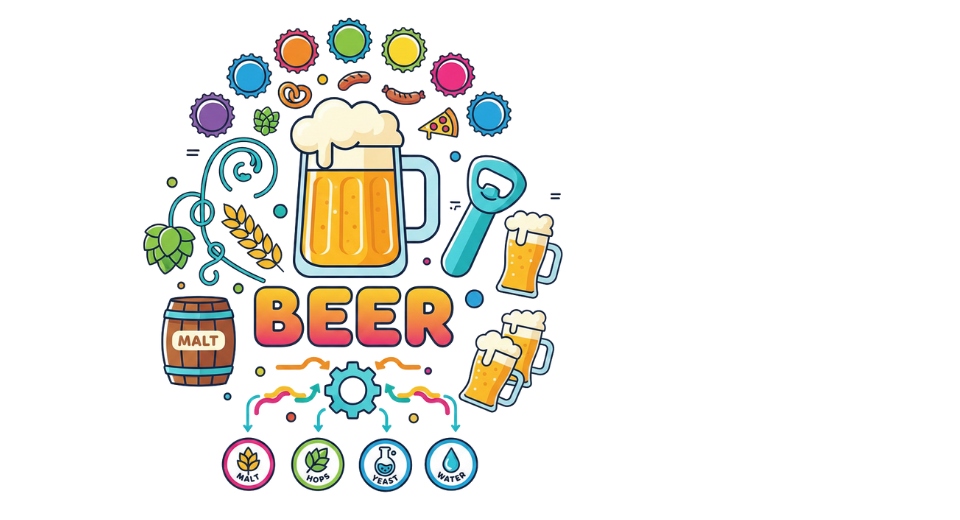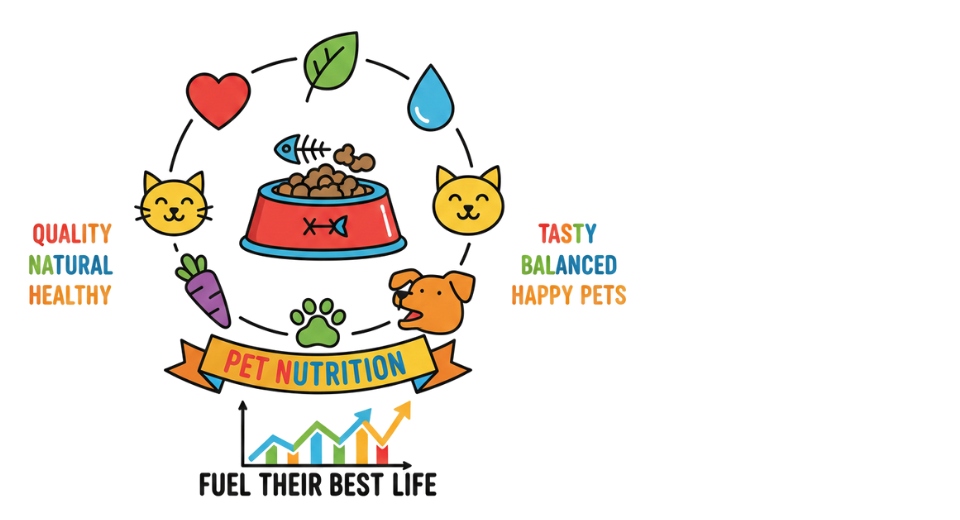MARKET OVERVIEW
The Mexican fast casual restaurant market will continue to shape the dining experience in North America and indeed the whole world. The food sector will not only influence consumer trends but also shape the way people interact with Mexican food within an environment that balances speed, flavor, and cultural authenticity. In contrast to traditional sit-down Mexican eateries, it will compete in a niche area where convenience and quality meet, serving individuals craving meals quickly without sacrificing taste or authenticity. To its core, the venture will be about customers' desire for recognized Mexican flavors presented in a setting that offers flexibility in eating as well as ordering.
Chains and standalone restaurants will experiment with recipes that highlight regional standbys and keep menus affordable. The appeal will be in serving hand-prepared burritos, tacos, bowls, and quesadillas that are made with easily seen attention. What distinguishes this market isn't food but also atmosphere atmospheres that support casual eating without being stodgy or unapproachable. In the coming few years, the mexican fast casual restaurant segment will act as a bridge between heritage culinary beginnings and contemporary lifestyles. The young population will play an influential role in expectations as they would opt for authenticity with speed and transparency of food-making processes.
The Mexican fast casual restaurant market will also see customers being drawn towards open-kitchen formats, where making tortillas or seasoning grilled meat becomes a part of the dining experience. This trend will allow restaurants to establish trust and loyalty, as the consumers will match the meal with craftsmanship as well as cultural diversity. The second feature of the industry will be its adaptability towards changing social trends. With people spending more time at work, at school, and on personal matters, eating meals that are convenient yet flavorful will become more popular. Operators in the mexican fast casual restaurant chain segment will respond to this by enhancing takeaway services, experimenting with fresh food packaging, and adopting technology for effortless ordering.
The web and mobile apps will not be an afterthought but integrated into day-to-day operations. In the meantime, the market will not abandon the social aspect of Mexican food. Seating will remain structured in a way that invites cliques of friends or co-workers to sit and eat their meals in a relaxed environment. The sensory experience bright colors, upbeat music, and aromas of grilled peppers and marinated meats will make meals not something mere eating but more of a social experience integrated into daily routines. As the mexican fast casual restaurant industry develops, it will show how cultural heritage can be blended in an updated eating format. Through combining efficiency with tradition, the industry will chart a future where Mexican cuisine retains its heritage yet accepts global eating palates. It will not be what is eaten but how the entire experience serves to complement the balance between convenience, flavor, and identity.
Mexican fast casual restaurant market is estimated to reach $61,078.53 Million by 2032; growing at a CAGR of 9.7% from 2025 to 2032.

GROWTH FACTORS
The Mexican fast casual restaurant market is gaining attention as changing food habits continue to influence how people choose to dine. Consumers are increasingly drawn toward meals that offer authentic taste and bold flavors, which has led to a stronger preference for ethnic and flavorful cuisines. This growing interest is not only boosting the appeal of Mexican dishes but also shaping how restaurants design their menus and dining experiences. The future of this market will be influenced by how well businesses adapt to these shifting preferences and provide options that match the expectations of modern diners.
A key driver for the Mexican fast casual restaurant market is the rising demand for healthier, fresh, and customizable food options. Many individuals are no longer satisfied with standardized meals and instead want food that reflects personal taste and dietary needs. The ability to choose fresh ingredients, adjust portion sizes, and explore different levels of spice makes Mexican cuisine a natural fit for this trend. With continued focus on health and wellness, restaurants that prioritize clean ingredients and transparency in preparation will likely attract a loyal customer base in the years ahead.
However, the Mexican fast casual restaurant market will also face challenges. Strong competition from both quick-service and full-service restaurants could slow down expansion. Established fast-food chains are constantly introducing new menu items to retain customers, while traditional full-service establishments highlight premium dining experiences. In addition, fluctuating ingredient costs can impact menu pricing and profitability. Items such as fresh produce, meats, and spices often experience price swings due to supply chain issues and global market pressures, making it harder for businesses to maintain consistent pricing without reducing quality.
Even with these challenges, opportunities remain significant. Expansion through franchising offers an effective strategy for reaching new customers and strengthening brand visibility. By entering untapped locations and catering to diverse demographics, businesses can establish a stronger presence and build long-term recognition. Market penetration, particularly in regions where demand for flavorful and convenient dining is growing, will also provide room for growth. The combination of authentic taste and fast service has the potential to capture a wider audience, especially as consumer interest in international flavors continues to rise.
Looking forward, the Mexican fast casual restaurant market will benefit from aligning with health trends, embracing menu innovation, and strategically expanding operations. The ability to balance affordability with quality while offering an enjoyable dining experience will play a central role in future success. With steady consumer interest and ongoing innovation, this market is positioned to remain an attractive segment of the food industry.
MARKET SEGMENTATION
By Meal Occasion
The Mexican fast casual restaurant market is set to move forward with new opportunities as dining habits change and customer expectations shift. Growth in this sector will not only be shaped by the quality of food offered but also by how well operators adjust to changing lifestyles, technology, and convenience-driven demand. With busy schedules becoming the norm, the market will expand as customers continue to look for meals that balance speed, freshness, and flavor without sacrificing value. This category will remain distinct from traditional fast food because of its focus on fresh preparation and cultural authenticity, while still offering the convenience that modern dining requires.
Future expansion of the Mexican fast casual restaurant market will be guided by the segmentation of meal occasions, covering breakfast, lunch, dinner, and snacks. Breakfast will likely grow as more people seek quick yet satisfying options at the start of the day. Portable items with authentic flavors will play a major role in drawing repeat visits during the morning rush. Lunch will continue to be a strong pillar, as office workers, students, and professionals rely on accessible and filling meals. Customizable bowls, tacos, and burritos will remain central during this occasion, offering flexibility and variety. Dinner will present even larger opportunities since families and groups often prefer a balance of convenience and quality at the end of the day. Restaurants that extend hours and create relaxed dining environments will gain a stronger presence in this part of the market. Snacks will bring another layer of growth as lighter menu choices become appealing between traditional meal times, opening the door for creative items that attract younger audiences seeking variety and affordability.
Technology will continue to support the Mexican fast casual restaurant market in the years ahead. Mobile ordering, delivery partnerships, and loyalty programs will encourage repeat traffic, while data-driven insights will allow menus to reflect changing tastes quickly. Sustainability efforts, including eco-friendly packaging and sourcing, will also help strengthen the trust between operators and customers. Expansion into new cities and international markets will further broaden the reach of this dining category, fueled by a growing global appreciation for Mexican flavors.
The Mexican fast casual restaurant market will remain resilient by staying flexible and focusing on what matters most to customers authentic taste, quick service, and value across every meal occasion. With strong potential in breakfast, lunch, dinner, and snacks, this segment will continue to adapt, innovate, and expand, shaping the future of convenient dining experiences worldwide.

By Sales Channel
The Mexican fast casual restaurant market will continue to grow as changing lifestyles and customer expectations shape the way food is consumed. Convenience and quality are the main driving factors that influence how people choose where and what to eat. With a focus on fresh ingredients and a faster dining experience, this market is expected to expand steadily in the future. Urban development, rising disposable income, and a preference for flavorful yet affordable meals will create more opportunities for operators to attract a wide customer base.
By sales channel, the Mexican fast casual restaurant market is divided into dine-in and takeaway. The dine-in segment will remain strong as people continue to value shared meals, social interaction, and the overall atmosphere provided by restaurants. Comfortable seating, appealing interiors, and quick service will be essential to keep attracting returning customers. Families and groups often prefer dine-in experiences, which means restaurants that invest in ambiance and service quality will benefit from steady demand. At the same time, the takeaway segment will show rapid growth as busy schedules and digital platforms push customers to look for quick solutions. Online ordering systems, mobile apps, and delivery partnerships will play a major role in shaping how this segment develops.
Future growth of the Mexican fast casual restaurant market will also depend on technology adoption. Digital menus, self-order kiosks, and personalized offers based on customer preferences will not only increase convenience but also improve overall satisfaction. Restaurants that embrace innovation will stand out in a competitive space. In addition, sustainability will gain importance as environmentally conscious choices become central to consumer behavior. Using eco-friendly packaging for takeaway, reducing food waste, and sourcing ingredients responsibly will strengthen trust and loyalty.
Changing demographics will also add new layers of opportunity. Younger generations often look for diverse flavor options while maintaining health-conscious habits. This will encourage more experimentation with ingredients and menu customization. On the other hand, older generations may value consistency and traditional dishes, giving operators a chance to balance innovation with familiarity.
The Mexican fast casual restaurant market will also expand geographically as more players enter suburban and smaller city areas, reaching beyond metropolitan zones. Expansion into these markets will allow operators to connect with communities that seek accessible and authentic dining experiences without the higher prices of full-service restaurants.
Overall, the combination of dine-in and takeaway channels will secure a balanced path of growth. With rising interest in convenience, digital engagement, and sustainable practices, the Mexican fast casual restaurant market will continue to shape modern dining habits while adapting to future consumer needs.
|
Forecast Period |
2025-2032 |
|
Market Size in 2025 |
$32,443.66 million |
|
Market Size by 2032 |
$61,078.53 Million |
|
Growth Rate from 2025 to 2032 |
9.7% |
|
Base Year |
2024 |
COMPETITIVE PLAYERS
The Mexican fast casual restaurant market has been gaining steady attention as consumer demand for fresh ingredients, bold flavors, and quick service continues to grow. This market will not only expand in terms of customer reach but also through technological innovation and creative menu offerings. With rising interest in healthier dining choices, the segment will focus on providing meals that balance taste with nutrition, while still offering the convenience that customers expect. The industry will continue to thrive by adapting to shifting food trends and the increasing need for sustainable practices.
Competition will remain intense as many established names push forward with strategies to retain customer loyalty while attracting new audiences. Key players such as Baja Fresh, Chipotle Mexican Grill, Chronic Tacos, Del Taco, Dos Toros Taqueria, Freebirds World Burrito, Guzman y Gomez Limited, Mad Mex, Moe’s Southwest Grill, On The Border, Pancheros Mexican Grill, QDOBA Mexican Eats, Rubio’s Coastal Grill, Taco Bell, Taco Cabana, Taco Del Mar, Taco John’s, Velvet Taco, and Zambrero have already established strong recognition. These brands will strengthen their presence by investing in digital platforms, loyalty programs, and delivery partnerships that allow them to reach customers more efficiently.
The Mexican fast casual restaurant market will also see a rise in experimentation with new flavors and customizable options. As consumer expectations evolve, innovation will become a defining factor in determining long-term success. Menu personalization, plant-based alternatives, and sustainable packaging will all play an important role in shaping the future direction of this sector. Competitive players will not only focus on expanding store locations but also on improving the customer experience through mobile ordering, faster service, and flexible dining formats.
Global expansion will be another major goal for many of these brands, as international markets provide opportunities for revenue growth and greater cultural influence. As more regions embrace Mexican-inspired food, competitive players will adapt their menus to local preferences while maintaining signature offerings that define their identity. In addition, partnerships with technology companies will enhance data-driven strategies, helping restaurants anticipate customer needs and respond with greater precision.
The Mexican fast casual restaurant market will continue to evolve as competitive players compete to stand out. Those that succeed will likely be the ones that balance authenticity with innovation, efficiency with quality, and tradition with forward-looking strategies. With strong competition and growing consumer expectations, this industry will remain dynamic, promising, and filled with opportunities for those willing to adapt to the future of dining.
Mexican Fast Casual Restaurant Market Key Segments:
By Meal Occasion
- Breakfast
- Lunch
- Dinner
- Snacks
By Sales Channel
- Dine-In
- Takeaway
Key Mexican Fast Casual Restaurant Industry Players
- Baja Fresh
- Chipotle Mexican Grill
- Chronic Tacos
- Del Taco
- Dos Toros Taqueria
- Freebirds World Burrito
- Guzman y Gomez Limited
- Mad Mex
- Moe’s Southwest Grill
- On The Border
- Pancheros Mexican Grill
- QDOBA Mexican Eats
- Rubio’s Coastal Grill
- Taco Bell
- Taco Cabana
WHAT REPORT PROVIDES
- Full in-depth analysis of the parent Industry
- Important changes in market and its dynamics
- Segmentation details of the market
- Former, on-going, and projected market analysis in terms of volume and value
- Assessment of niche industry developments
- Market share analysis
- Key strategies of major players
- Emerging segments and regional growth potential








 US: +1 3023308252
US: +1 3023308252






